When you first imagine the electric guitar, the shape of the Fender Stratocaster is likely the first one that springs to mind. It has been in constant production since its first release in 1954.
Born in a prescient era, it’s emblematic of rebellion, rock ‘n’ roll and a completely new direction in music that would take the world by storm and inspire generations to come.
The Fender Stratocaster defines iconic and as such, it has more than a modest story to tell. There are the legends who made it their own — its myths and legends — but also the fact that this is a guitar for everyone.
This is the story of the Fender Stratocaster.
Compiled and edited by Dan Shaw
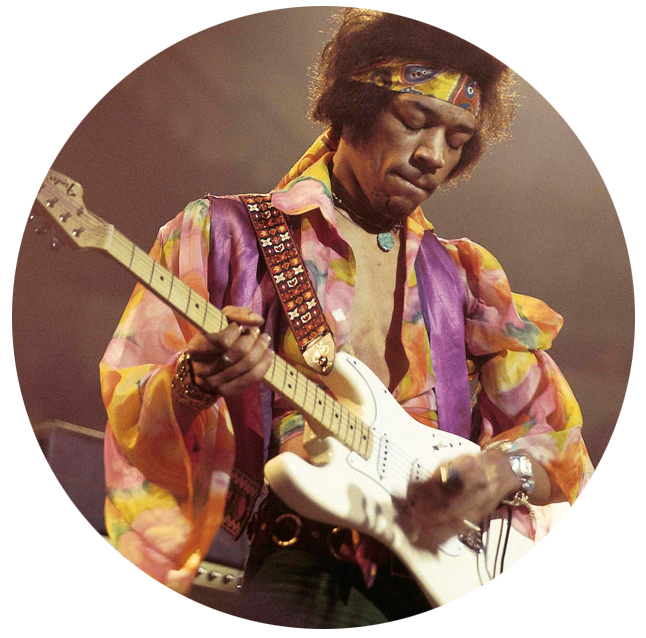
The origins of the Fender Stratocaster
by Jack Foley
The Stratocaster is the quintessential electric guitar. Its invention in 1954 was not just a significant development in the evolution of the guitar but also a seminal moment for 20th-century design. It marked the moment when the electric guitar severed ties from the acoustic guitar to become an entirely new entity.
Like many great inventions, the motivations for creating the Stratocaster were practical in nature. The Stratocaster was preceded by the Telecaster (originally called the Broadcaster) in 1948. Many of the innovative features on the Stratocaster came from attempting to improve the Telecaster.
The Telecaster was created by Leo Fender, the founder of Fender Guitars. It was the first mass-produced and commercially successful solid-body electric guitar. Whilst it enjoyed commercial success, the team at Fender Guitars felt that the Telecaster was too basic. They needed an upgraded model to compete with other high-end manufacturers.

Work on the Stratocaster began in 1951 and by late 1952, many of the distinct Stratocaster features, such as the pickups and bridge, had emerged. Interestingly, Leo Fender never learnt to play the instrument that he pioneered and that his name would become synonymous with. To compensate, he often relied on a team of guitar players around him to give practical advice on design and playability.
These guitar-playing contributors included Freddie Tavares, Bill Carson and Rex Gallion. In this way, the Stratocaster was a collaborative effort between Leo Fender and the team of guitar players around him. The name ‘Stratocaster’ itself came from Fender sales chief Don Randall because he wanted for players to feel like they been “put into the stratosphere“.
The first production run of the Stratocaster was in October 1954. Surprisingly, the impact of the Stratocaster wasn’t immediate. For the first decade of its existence, it remained largely uncelebrated in obscurity (aside from a few key figures in early rock ‘n’ roll. It wasn’t until the 1960s — when it was adopted by high profile players such as Jimi Hendrix and Eric Clapton, that the Stratocaster began to penetrate the culture at large.
The name ‘Stratocaster’ itself came from Fender sales chief Don Randall because he wanted players to feel like they’ve been “put into the stratosphere”.
There are two core elements that made the Stratocaster groundbreaking: the shape and the tone. Specifically, the Stratocaster’s ergonomics and the breadth of its tonal capabilities. Before the Stratocaster, electric guitars mostly resembled acoustic guitars in physical shape, proportions and design. The Stratocaster rethought the shape and added contours to meet the modern player’s needs.
Solid-body guitars don’t have the physical constraints that acoustic or semi-hollow guitars have. Since there isn’t a sound chamber, the solid-body electric can be more versatile in its shape. Yet no solid body model before the Stratocaster capitalised on this newfound freedom. Its predecessors still had squared off edges in the style of acoustic guitars. The Stratocaster adjusted the shape to increase playability and comfort. It added contours to the body meaning it sat more naturally.
The new design wasn’t just about comfort and aesthetic. The Stratocaster also pioneered the cutaway shape, allowing the player to use the higher frets with greater ease. This opened up new ways of playing and has become commonplace for electric guitars.
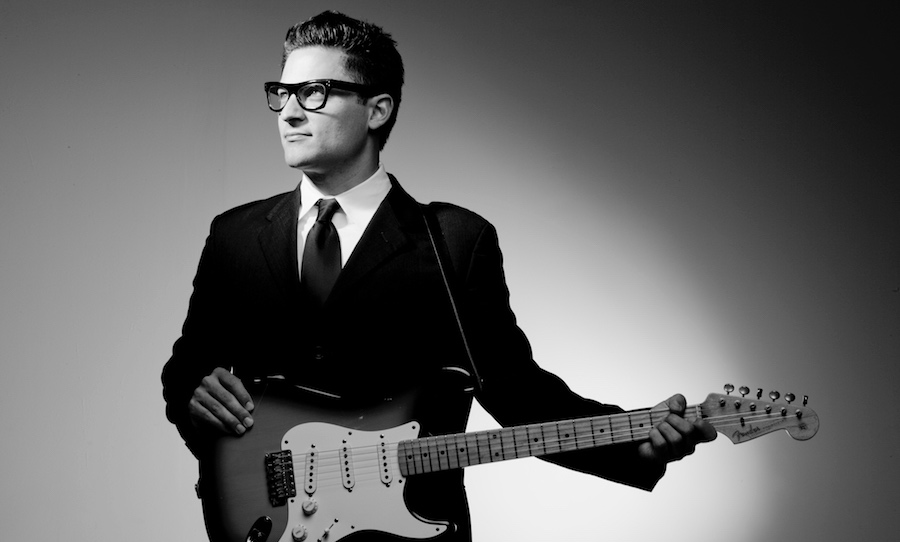
The Stratocaster introduced several groundbreaking functional features that helped it find its unique voice. It was the first Fender product to have three pickups, enriching the guitars overall tone. Three pickups also meant that players could control their tone more precisely. On the Telecaster, two strings shared the same bridge section. The Stratocaster gave each string its own string section on the bridge, improving intonation.
Another significant technical achievement of the Stratocaster is its spring tension vibrato system, commonly known as a whammy bar or tremolo bar. The new device temporarily alters the pitch and adds vibrato, giving players completely new modes of playing and expression. It became an important tool for countless guitar players and is an integral part of many genres.
A testament to the quality of the Stratocaster is the endurance of its design. It has barely changed in almost seven decades. Rather than becoming obsolete or overlooked, Stratocasters are still amongst the most sought after guitars by players and collectors alike. Leo Fender and Fender Guitars would go on to invent and develop many other iconic guitars and amplifiers, yet none would have the lasting cultural impact of the ‘Strat’.
7 Legendary Fender Stratocasters
by Luka Osborne
Buddy Holly’s 1955 Sunburst Stratocaster
First on the list, and first to popularise Stratocasters in rock music, is Buddy Holly. The Stratocaster had been designed with country in mind but with more versatility than its stablemate the Telecaster. Holly blew everyone out of the water when he began to use the Strat for rock ‘n’ roll.
It was 1955 when he bought his first Strat from Adair Music in Texas, borrowing a bit of money from his generous brother. It had an ash body, maple neck and sunburst finish, and along with his thick-rimmed glasses, crisp suits and lanky stance, he made dorky look cool for the first time ever. Holly’s appearance on the Ed Sullivan show cemented this image and introduced the Strat to the masses for the first time.
The Stratocaster had been designed with country in mind but with more versatility than its stablemate the Telecaster.
He was known to toggle through pickups and fiddle with his tone knob endlessly to create different dynamics. For Holly, the Strat offered all the flexibility he needed. His fingerpicking blended lead and rhythm styles, often using downstrokes in a style similar to sweep picking. His chugging rhythms and lead lines that would go on to inspire new generations of rock musicians.
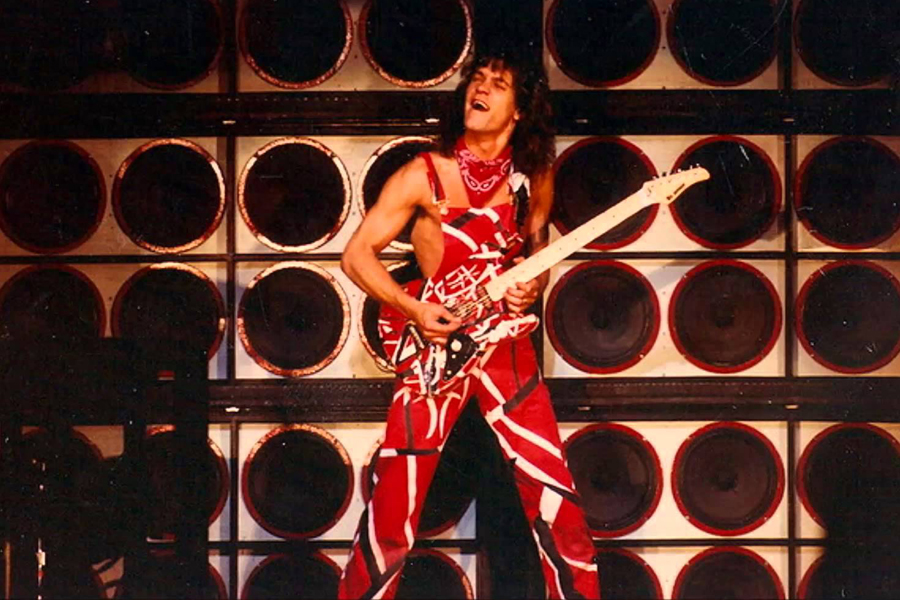
Eddie Van Halen’s ‘Frankenstrat’
One of the stranger entries on this list, Eddie Van Halen’s noble steed is one to make Fender purists cringe. For the rest of us though, there’s definitely something cool about his custom paint job.
Van Halen liked the feel and playability of the Stratocaster, and don’t we all. The curved shape fits well against the body and is well balanced with the neck. The metal pioneer, however, wanted something with a thicker tone, without having to succumb to a thicker body (i.e. a Gibson).
So, he figured he would have the best of both worlds by taking a beefy Gibson PAF pickup from an ES-335 and wiring it into a Strat body he had picked up for $50 at a factory seconds outlet. He also potted the pickups with paraffin wax to reduce microphonic feedback.
Layers of paint were added, with masking tape strips, giving the guitar the infamous Pollock-like streaky finish. Finally, he whacked a Gibson decal on the headstock to emphasise the cross-over. Talk about a home job.

Hank Marvin’s ‘Fiesta Red’ Strat
This is basically what every 10-year-old pictures when they beg their parents for their first guitar.
Another early adopter of the guitar, The Shadows’ lead guitarist settled on a Strat after seeing Buddy Holly wielding one on his Crickets album covers. He ordered the top of the range model and was immediately enamoured by its futuristic looks, as well as its tremolo system, a handy little addition that would go on to define the Shadows’ early releases.
His particular guitar also came with thick gauge strings (13-56). This limited Marvin’s ability to bend notes, however, the thicker strings produced a rich sound, and rather than changing them, Marvin accustomed himself to bending the tremolo arm during his licks, creating the infamous surfy, spaghetti western tones that he became famous for.
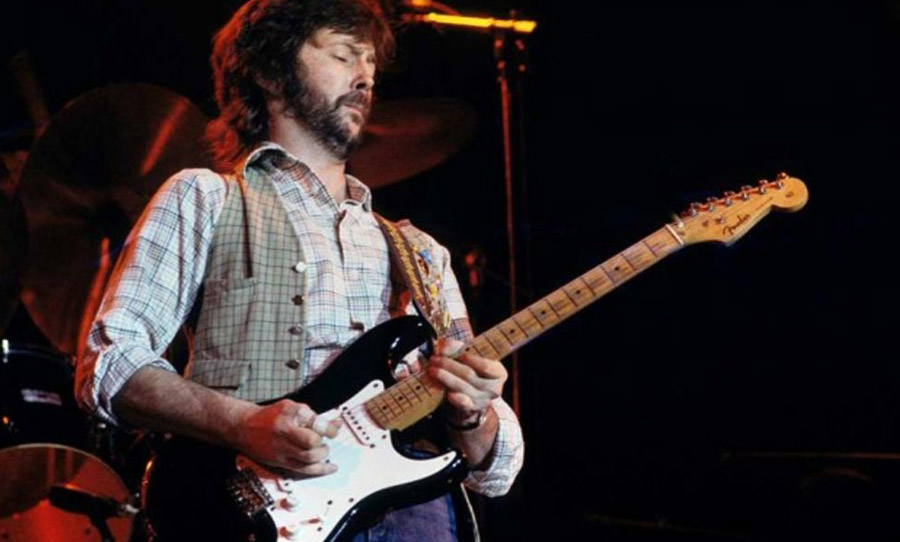
Eric Clapton’s ‘Blackie’
Eric Clapton’s ‘Blackie’ is one of the most famous Stratocasters in rock history, however, it wasn’t exactly love at first sight. In his early career, Clapton played everything but a Strat. His Cream sound was defined by Gibson SGs, and in the late ’60s, he experimented with Jazzmasters, Les Pauls and Telecasters. But, by the turn of the decade, he decided it was time to give the Strat a go.
While in Nashville, Clapton visited a guitar shop called Sho-Bud, which had a number of 1950s Stratocasters all going cheap (can you imagine?), the earlier model looking outdated next to the shmick late ’60s and ’70s model with its fat, funky headstock.
He stocked up, buying a number of them, giving some as gifts to the likes of Steve Winwood, George Harrison and Pete Townsend. He kept a few and decided to make his own from the best parts of three models; so good was the sound of the resulting guitar, dubbed ‘Blackie’, that he used it for just about every gig thereafter. Clapton described the process in an interview with Music Radar:
“I made Blackie out of a group of them. I took the pickups out of one, the scratchplate off another, the neck off another and I made my own guitar, like a hybrid guitar that had all the best bits from all these Strats.”
These days ’50s Strats go for monumental amounts of money, but Blackie took the cake back in 2004 when it sold for $959,500 at auction.

David Gilmour’s ‘Black Strat’
David Gilmour’s legendary black Stratocaster, simply named ‘The Black Strat’, joined the Pink Floyd family shortly after he did. Perhaps what makes the guitar so legendary is, in Gilmour’s constant pursuit of tone perfection, the way he regularly modified for years after its purchase.
Bought from the famous Manny’s guitar store in New York in 1970, the guitar has had just about every part – bar the body – swapped and changed. It can be seen in a relatively stock-state during the ’71 Live at Pompeii concert, however soon after he added a ’50s rosewood neck and drilled a hole in the side to fit an XLR input to eliminate noise from his Dallas Arbiter Fuzz Face.
The guitar sported a Gibson humbucker for a short stint in 1973, and in 1974 the guitar scored its defining black scratchplate. A new maple neck soon followed. Perhaps the most intuitive modification of the Black Strat was the addition of a custom toggle switch which allowed Gilmour to select the neck and the bridge pickups, which a normal Strat wouldn’t allow.
The guitar has featured on many legendary tracks over Pink Floyd’s career, such as Money, Shine On You Crazy Diamond and Comfortably Numb.
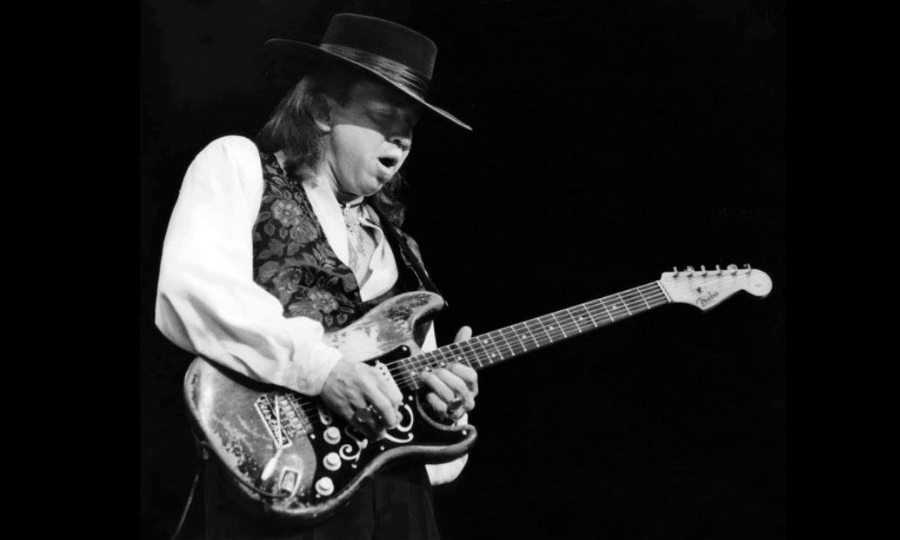
Stevie Ray Vaughan’s ‘Number One’ (aka ‘First Wife’)
Stevie Ray Vaughan was a big ambassador for the Stratocaster. He played a number of different models in his career, but the most famous is his ‘Number One’. The guitar was given to him by the owner of Ray Henning’s Heart of Texas music shop in 1973, and was his main companion throughout his career, Vaughan sometimes referring to it as his ‘first wife’.
The guitar’s body was from a ’62 model and the neck was from a ’63, with a rosewood fingerboard. He reversed the tremolo for ease of access (inspired by Jimi Hendrix) and added his initials ‘SRV’ in white along the side.
He was said to be frisky with his guitars, his Number One wearing many battle scars from its long years on the road. Coupled with an Ibanez Tubescreamer, the guitar produced the classic blues tones heard on all of his studio albums, singing licks on tracks such as the infamous Pride and Joy.
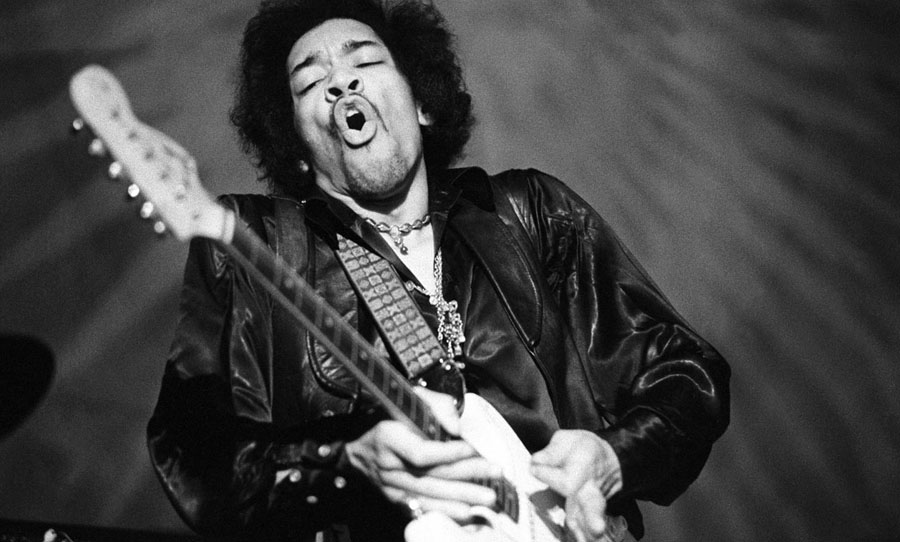
Jimi Hendrix’s ‘Woodstock’ Strat
No Stratocaster list would be complete without a mention of Jimi Hendrix. Although he was associated with numerous Strats over his short-lived career, he is probably best known for the Olympic white model he played at Woodstock.
Hendrix purchased the 1968 model from Manny’s music in New York, the new axe becoming a favourite of his. He treated the guitar well compared to some of his other units, which ended up as kindling. The model had a maple neck, featuring the larger late ’60s headstock. A flipped nut accommodated Jimi’s upside down/back-to-front stringing method.
A separate maple fretboard was another unique addition, which Fender offered for a short stint in the late 1960s. The guitar was used until his final live performance at the Isle of Fehmarn in September 1970, from which The Experience’s drummer Mitch Mitchell took ownership. In a statutory declaration for the guitar’s auction, Mitchell Stated:
“I said to him ‘I’ll have that guitar before you break it up’ (I do not think that he would, in fact, have broken this particular guitar). He said, as was his way “You got it” and he then gave me the guitar. In retrospect, I think it was by way of a gift as my daughter had just been born a few days previously.”
The white Strat was purchased in 1998 by Microsoft co-founder Paul Allen for 2 million dollars, making it the second most expensive guitar ever sold at that time.
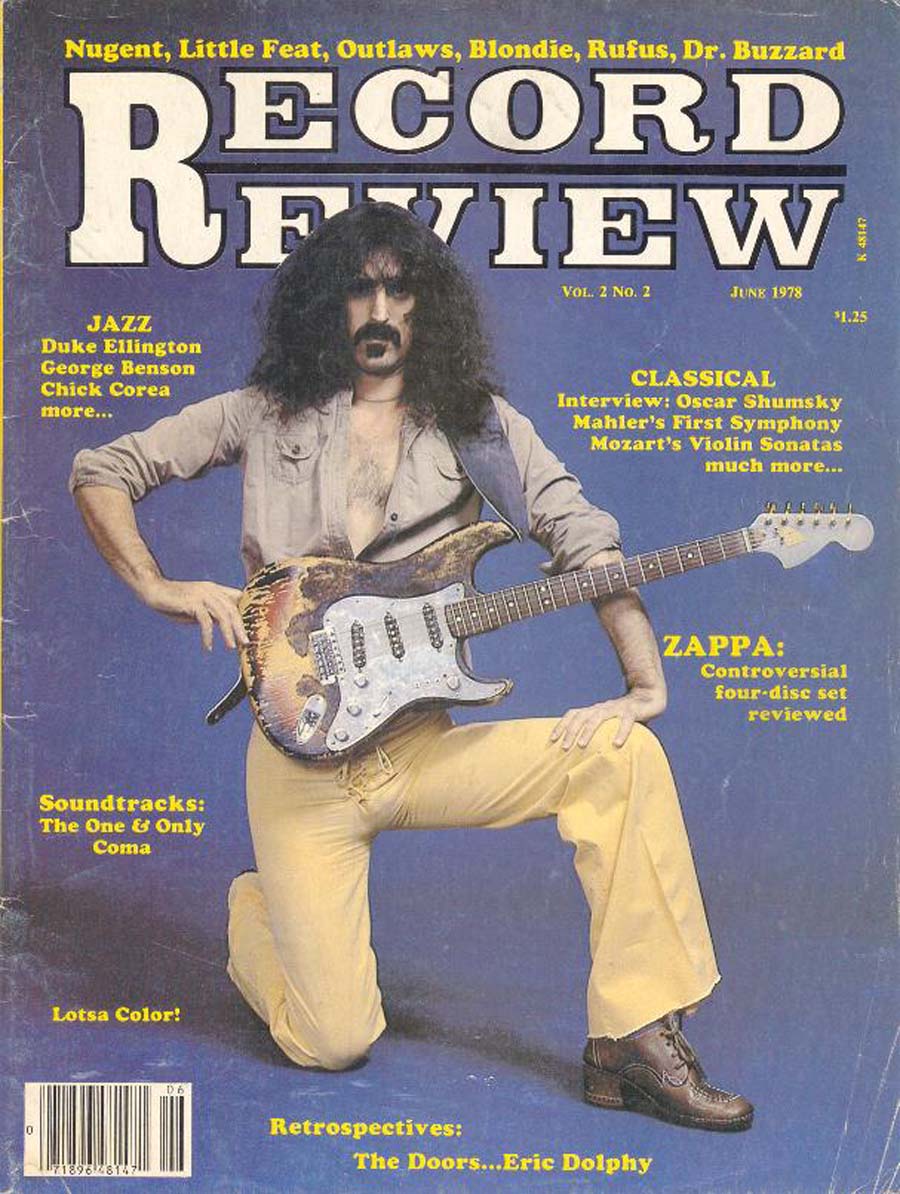
The tale of the burnt Fender Stratocaster
by Dan Shaw
Sure, the purists will tell you that it’s the chops that matter, not the gear. Most times it’s easy to agree. Yet in the case of one particular Fender Stratocaster, there’s a strong argument that there are a select few instruments that transcend the skills of the player and possess a soul of their own.
Jimi Hendrix and Frank Zappa rose to prominence at around the same time. The two admired each other’s work and were connected by a Fender Stratocaster that was burned on stage by Hendrix and eventually found its way into the possession of Zappa. This piece of charred timber and molten metal links two of the 20th century’s most influential exponents of rock. Surprisingly, it lives on.

As anyone who survived the counterculture revolution will tell you, The Jimi Hendrix Experience live show was a pretty wild ride. He was known for all kinds of showboating – playing strings with his teeth and behind his back and smashing up stages, all the while treating audiences to an unprecedented display of virtuosity and attitude in rock guitar.
Though this generation was enjoying a cultural awakening, audiences surely wouldn’t have seen this power trio coming. The same could be said about the audiences of Frank Zappa. Though he approached music in a different way, his complex and bizarre take on psychedelic rock and jazz must’ve been mind-blowing on first look. It still is.
It only makes sense that these two iconoclastic forces would have taken an interest in each other’s music. During the “Summer of Love” 1967, the two rendezvoused in New York. They had both been conducting separate experiments with new innovations like the Wah pedal and Hendrix was known to see Zappa and the Mothers of Invention during their residency at The Garrick in Greenwich Village.
The two later performed together at the Underground Pop Festival in Florida, but it was another the festival in that state later that year that the mythology surrounding the burned Fender Stratocaster took root. Back in 1977, Zappa told Guitar Player magazine that, “Another one of my Strats is the one Hendrix burned at the Miami Pop Festival.”
But did the guitar actually come from this hallowed festival set? Well, there’s some conjecture around that as well. In March 1967, The Experience kicked off their first UK tour with a show at The Astoria in London and as a stunt to make a name for themselves, Hendrix lit his Fender Stratocaster on fire. The whole scene was pretty dramatic, according to the Melody Maker journalist Chris Welch, who witnessed the scene:
“Jimi leapt backwards and ran off stage followed by his group. The guitar was left burning dangerously near the closed curtains… An attendant rushed on stage with a fire extinguisher and put out the flames which were leaping ten feet in the air.”
Aside from the accounts from both of these “hot” shows, there is precious little evidence to prove where Zappa’s inherited Strat came from. Zappa believed it to be cremated in Miami, other theories suggest that it came from the fabled, fiery Astoria show.
The guitar found a home in the Zappa trophy room until he decided to breathe some life into it once again. Once he reassembled the guitar, this Stratocaster took on a very different form: supercharged for a new generation.
It was fitted with a mirrored pickguard made from polished steel and custom blend knobs with sweepable EQ knobs. The guitar was immortalised on Zappa’s 22nd album, Zoot Allures and the cover of the January 1977 edition of Guitar Player magazine.
The guitar went onto have a stellar career in its own right and was even played by virtuoso Steve Vai and Adrian Belew when they were in Zappa’s band. After another several deconstructions in Zappa’s touring career, Dweezil Zappa, son of frank and lauded guitarist found the Fender in pieces beneath a staircase.
The younger Zappa took the relic to Fender and master builder Jay Black restored it to its former glory, featuring a maple neck, traditional electronics and as a nod to Jimi Hendrix, a flipped headstock. When Dweezil officially inherited the guitar, however, he had a new neck installed and changed the electronics to suit the expansive sonic options of the Zappa style.
So, whatever the origin, it clearly isn’t your run of the mill Strat. The most popular electric guitar in the world flourishes in many forms, but it’s rare to discover a single instrument which has seen so much and shared between two players that embody two markedly different, yet equally groundbreaking approaches to rock ‘n’ roll.

Finding your dream Fender Stratocaster
by Dan Shaw
The Fender Stratocaster is synonymous with most people’s idea of the electric guitar. With so many examples alive and well in the world, that it must be easy to find the perfect one for you, right?
Well, being such a famous guitar has its drawbacks – like any celebrity, it has a huge number of haters as well as lovers. The design, largely unchanged for decades must be getting something right though, as evidenced by the players of a multitude of styles who have favoured the Strat. Therefore, let the stars guide you in the search for your best Stratocaster.
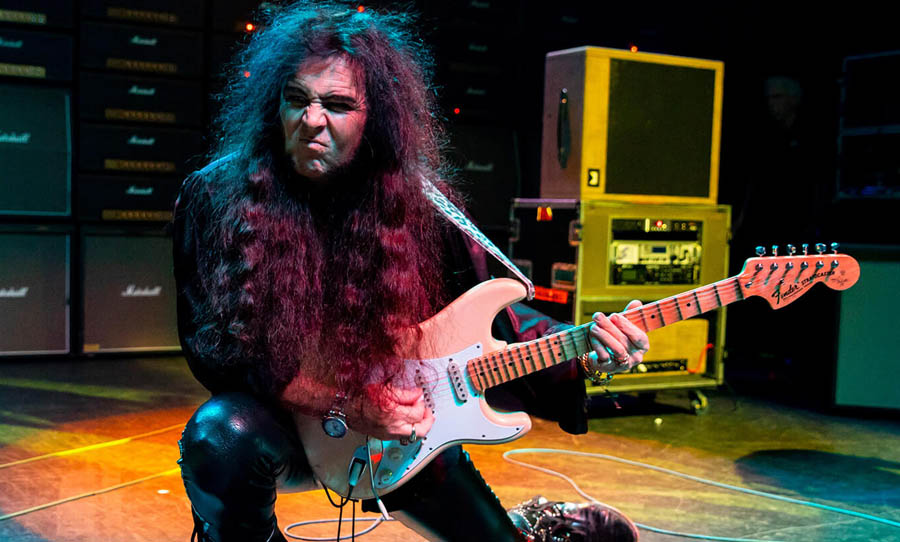
The first Stratocaster rolled out of the Fender factory in 1954. Spurred on by the development of the rock ‘n’ roll craze that was sweeping the world, Fender realised there was an opportunity to capitalise on the need for robust and reliable solid-body guitar with looks to die for.
One of the first famous exponents of the new-fangled piece of technology was Buddy Holly. He bought a Sunburst Strat with an ash body and maple neck in 1955 and never looked back. In an age when effects pedals were a twinkle in the eye, Holly manipulated the pickup switch and tone knob to create his signature sounds: a big tick for the versatility inherent in the controls of the guitar.
Hank Marvin of The Shadows was another key early adopter. And though the heavy-gauge strings that he favoured restricted his ability to bend strings, his ’59 model was fitted with a floating tremolo system, perfect for his booming clean tone leads, with Spaghetti-Western inspired vibrato tails.
This early era of the Stratocaster – before the company’s takeover by CBS in 1965 – produced very high-quality instruments. As such, guitars of this vintage can fetch insanely high prices. The relics of the Fender Custom Shop make the models from this epoch at least a little more accessible. They’re newly made with strict adherence to the specifications of the time.
Blues music is the ultimate vehicle for guitar – repetitive song structures, ample room for soloing and the use of pentatonic scales that are just made for the fretboard. With the Stratocaster being the most popular of electric guitars and capable of pulling a wide range of tones, it was only natural that this axe would be adopted by classic blues slingers.
Interestingly, two of the pivotal blues Strats straddled both sides of the infamous CBS takeover. Eric Clapton’s ‘Blackie’ was actually an amalgam of a few different late ’50s models, which demonstrates that the guitar is also quite easy to modify – so don’t be afraid to customise your own perfect model.
Jimi Hendrix’s immortal Olympic White Strat that he played at Woodstock was made in 1968. By this stage, the Stratocaster had grown its headstock, but not much had changed under the hood since the guitar’s advent in the early ’50s. Of course, what set Hendrix apart was how he played the damn thing, not the minutiae of specs, or lapses in quality control at the Fender factory. His style – more so than the guitar itself – is the true mark of the Strat’s capability.
Another Strat from this so-called dark period in the history of the company was David Gilmour’s ‘Black Strat’. Gilmour’s guitar recently sold at auction for a world record price of $3.975 million USD. Of course, the lucky owners of this piece of rock history aren’t likely to take it to the pub to play a gig, but it goes to show that while wasn’t of the most salubrious vintage, this ’69 Strat could make a quite a good sound. The models from this era can still fetch a pretty penny, but not quite as much as those from a decade earlier.
Beyond the guitar gods of the vintage blues and rock era, the Stratocaster also found a home in glam-rock and hair-metal, adopted by certified shredders of all types. Eddie Van Halen, for example, was a fan of the famous guitar, but the traditional stylings of yesteryear weren’t going to cut it for him.
His ‘Frankenstrat’ consisted of Gibson PAF pickup, a stack of paraffin wax crammed into the pickup cavities to reduce microphonic feedback, topped off with a hell of a lot of paint and masking tape.
Swedish neo-classical shredder Yngwie Malmsteen is another exponent of the Stratocaster. On first glance, his preferred setup seems more conservative than that of Van Halen’s, but on further inspection, it reveals something altogether more unusual – a scalloped fretboard. The concave carvings between each of the frets allows him to slide effortlessly all over the fretboard with blinding speed. So it turns out the humble Strat can be supercharged!
The Stratocaster, more so than most, has an eye toward its glorious legacy. And why wouldn’t it? Immortalised by some of the most iconic players in history, the past glories of this guitar are worth celebrating. Fender has, however, sought ways to ensure that this model maintains relevance.
With the Parallel Universe series, for example, the iconic silhouette has taken on the traits of the Telecaster and Jaguar, alternative pickup configurations like humbuckers and true-to-the-period Nocaster pickups are fitted to new Strats, metalheads can indulge their dive-bomb fetishes with Floyd-Rose tremolo systems and more.
All these variations on the Strat speak to the guitar’s versatility — it can function as a blank canvas that you indelibly mark with your personality. Paradoxically, it also says something about its individualism – despite its ability to take on several forms, this particular guitar is always recognisable.
So whether you’ve got your heart set on a vintage model, or you’re keen to push the boundaries of what an electric guitar can be, the Fender Stratocaster that’s right for you exists somewhere in this world.